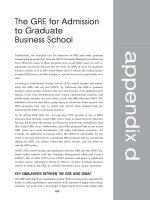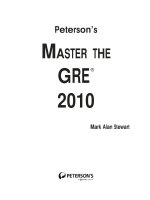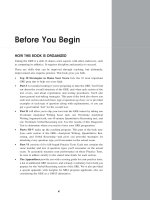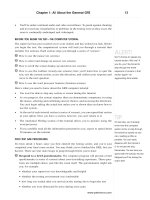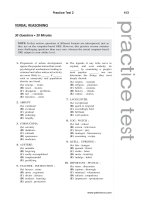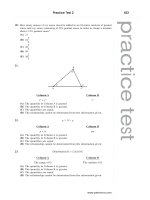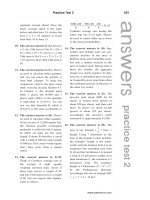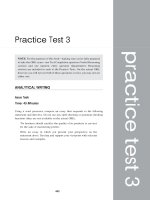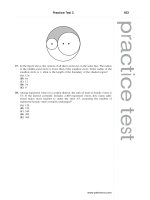Tài liệu Master the Gre 2010 - Part 17 pptx
Bạn đang xem bản rút gọn của tài liệu. Xem và tải ngay bản đầy đủ của tài liệu tại đây (42.22 KB, 10 trang )
Quoting the Statement or Argument
Occasionally, it may be appropriate to quote key words or phrases from the Issue
statement or Argument statement. For example, you may wish to point out a key
phrase that is ambiguous or vague (“certain respondents”), or a term that is overly
inclusive or exclusive (“only” or “all”). This is fine, as long as you keep the number of
quoted words and phrases to a minimum; there’s never any justification for quoting
entire sentences.
MAINTAIN PROPER TONE AND VOICE
In any type of essay writing, you should maintain a somewhat formal tone
throughout. An essay that comes across as conversational is probably too informal
for the GRE.
The overall tone should be critical but not inflammatory or emotional. Don’t overstate
your position by using extreme or harsh language. Don’t attempt to elicit a visceral or
emotional response from the reader. Appeal instead to the reader’s intellect.
A direct, even forceful voice is perfectly acceptable for making your main points. But
don’t overdo it; when it comes to the details, use a more dispassionate approach.
Don’t try to make your point with “cutesy” or humorous remarks. Avoid puns, double
meanings, plays on words, and other forms of humor. Likewise, sarcasm is entirely
inappropriate for your GRE essays. The reader may not realize you’re being sarcastic,
in which case your remark will only serve to confuse him or her.
VARY SENTENCE LENGTH AND STRUCTURE
To ensure high GRE essay scores, strive to write sentences that vary in length and
structure in a way that helps convey their intended meaning rather than obscuring or
distorting it. Here are some examples:
• For rhetorical emphasis, try using an abrupt, short sentence to make a crucial
point, either before or after longer sentences that elucidate that point.
• Use a semicolon to transform two sentences involving the same train of thought
into one; and use the word “and” to connect two independent clauses (just as in
this sentence).
• Sentences with the same essential structure can help convey your line of rea-
soning to the reader. Try using the similar structures for a list of reasons or
examples.
• Sentences that essentially repeat (verbatim) throughout your essay suggest an
immature, unsophisticated writing style. Try to avoid using so-called template
sentences over and over, especially for the first and last sentence of each body
paragraph.
Chapter 6: Writing Style and Mechanics 143
www.petersons.com
WRITE CLEARLY AND CONCISELY
You’re most likely to score high on your GRE essays if you develop a clear and concise
writing style. Frequent occurrences of awkward, wordy, or redundant phrases can
lower your Analytical Writing score—especially if these problems interfere with the
reader’s understanding of your essay.
Beware of Wordiness
With enough words, anyone can make a point, but it requires skill and effort to make
your point succinctly. As you proofread your essay, if a sentence seems clumsy or
overly long, check for a wordy or awkward phrase that you can replace with a more
concise, clearer one.
In your Argument essay, for example, you can often replace wordy phrases that signal
a premise with a single word. For example: “the reason for,” “for the reason that,” “due
to the fact that,” “in light of the fact that,” and “on the grounds that” can be replaced
with “because,” “since,” and “considering that.” Here are some additional examples:
Original: Discipline is crucial to the attainment of one’s objectives.
Better: Discipline is crucial to attain one’s objectives.
Original: To indicate the fact that they are in opposition to a bill, legislators some-
times engage in filibusters.
Better: To show that they oppose a bill, legislators sometimes engage in filibusters.
Original: The employee with ambition
Better: The ambitious employee
Original: The system which is most efficient and accurate
Better: The most efficient and accurate system . . .
Original: Both unemployment levels as well as interest rates can affect stock prices.
Better: Unemployment levels and interest rates can affect stock prices.
Original: The reason science is being blamed for threats to the natural environment
is because scientists fail to see that technology is only as useful or as harmful as those
who decide how to use it.
Better: Science is being blamed for threats to the natural environment because
scientists fail to see that technology is only as useful or as harmful as those who
decide how to use it.
Watch Comma Placement
Although punctuation is the least important aspect of your GRE essays, habitually
overusing, underusing, or misusing commas may not only interfere with the reader’s
understanding of your essay and interrupt the flow of your sentences, but it may also
contribute to a lower score. Use the least number of commas needed to ensure that the
reader will understand your point.
PART III: Analytical Writing144
NOTE
To speed up the writing
process, some GRE test takers
copy and paste phrases and
sentences, then “tweak” them
to avoid the template look.
There’s nothing wrong per se
with this strategy, but you’ll
probably find that it takes
more time than it’s worth.
www.petersons.com
USE LANGUAGE CORRECTLY AND PERSUASIVELY
To ensure top scores for your essays, strive to convince the readers that you possess
a strong command of the English language—in other words, that you can use the
written language correctly, clearly, and persuasively. You need to demonstrate a
solid grasp of vocabulary, use proper idioms (especially prepositional phrases), and
use proper diction (word usage and choice). Let’s take a look at how you can
accomplish this.
Demonstrate a Solid Grasp of Vocabulary
By all means, show the reader that you possess the vocabulary of a broadly educated
individual and you know how to use it. But keep the following caveats in mind:
• Don’t overuse “SAT-style” words just to make an impression. Doing so will only
suggest that you’re trying to mask poor content with window dressing.
• Avoid obscure or archaic words that few readers are likely to know. Readers do
not have time while reading essays to consult dictionaries.
• Avoid technical terminology that only specialists and scholars in a specific field
would understand. GRE readers are typically English-language generalists in the
fields of English and Communications.
• Use Latin and other non-English terms very sparingly. After all, one of the
primary skills you’re being tested on is your facility with the English language.
The occasional use of Latin terms and acronyms—for example, per se, de facto, ad
hoc, i.e., and e.g.—is perfectly acceptable. Non-English words commonly used in
academic writing, such as vis-á-vis, caveat, and laissez faire are acceptable as
well, but again, be careful not to overdo it.
• Avoid colloquialisms (slang and vernacular).
Use Proper Diction
In evaluating your essays, GRE readers also take into account your diction, especially
whenproblemsinterferewiththeunderstandingofyouressays.Diction referschieflyto
yourchoiceofwordsandtothewayawordisused.Whenyoucommitanerror in diction,
you might be confusing one word with another because the two words look or sound
similar.Oryou may usea word thatisn’tthe best choiceforconveying the ideayou have
in mind. Here’s an example of the first type of diction error:
The best way to impede employees to improve their productivity is to allow
them to determine for themselves the most efficient way of performing their
individual job tasks.
The word impede means “to hinder or hamper”; in the context of this sentence, impede
should be replaced with a word such as impel, which means “propel or drive.” The test
taker might have confused these two words. Now here’s an example of the second type
of diction error:
Unless the department can supply a comparative cost-benefit analysis for
the two alternative courses of action, I would remain diffident about fol-
lowing the department’s recommendation.
Chapter 6: Writing Style and Mechanics 145
NOTE
The rules for Standard Written
English require that Latin and
other non-English terms be
italicized (or underlined).
However, GRE wor d processors
don’t allow you to do so. You
can leave words like this as is,
but be sure they’re terms that
most educated people would
know.
www.petersons.com
The word diffident means “reluctant, unwilling, or shy.” A more appropriate word here
would be ambivalent, which means “undecided or indecisive.” Or perhaps the test
taker meant to use the word indifferent, thereby committing the first type of diction
error.
What appear to be diction errors might in many instances be merely typing errors.
Accordingly, problems with your word choice and usage will adversely affect your
scores only if they are obvious and occur frequently.
Use Idioms Correctly
An idiom is a distinctive phrase that is either proper or improper based upon whether
it has become acceptable over time and through repeated and common use. Here are
two sentences, each of which contain an idiomatic prepositional phrase and another
idiom:
Example (From a Typical Issue Essay):
The speaker’s contention flies in the face of the empirical evidence, and in any
event runs contrary to common sense.
Example (From a Typical Argument Essay):
For all we know, last year was the only year in which the company earned a
profit, in which case the vice president’s advice might turn out to be especially
poor in retrospect.
Idioms don’t rely on any particular rules of grammar; hence they are learned over
time by experience. As you might suspect, the English language contains more idi-
omatic expressions than you can shake a thesaurus at. Moreover, the number of
possible diction errors isn’t even limited to the number of entries in a good unabridged
English dictionary. Although it is impossible in these pages to provide a thorough
review of diction and idiom, here are some guidelines to keep in mind when writing
your GRE essays:
• If you’re the least bit unsure about the meaning of a word you want to use in your
essay, don’t use it. Why risk committing a diction blunder just to impress the
reader?
• If a phrase sounds wrong to your ear, change it until it sounds correct to you.
• The fewer words you use, the less likely you’ll commit a diction or idiom error.
When in doubt, stick with a relatively brief phrase that you think will still convey
your point.
• If English is your second language, take heart: In evaluating and scoring your
essays, GRE readers take into account diction or idiom problems only to the
extent that those problems interfere with a reader’s understanding of your sen-
tence’s intended meaning. As long as your writing is understandable to your EFL
(English-as-First-Language) friends, you need not worry.
PART III: Analytical Writing146
TIP
If you have time before your
exam and you think your
diction and use of idioms need
improvement, consult a
reputable guide to English
usage, a trusted professor, or a
colleague with a firm grasp of
Standard Written English.
www.petersons.com
SUMMING IT UP
• GRE essay readers place less weight on writing style and mechanics than on
content and organization—but the way you write can affect your GRE Analytical
Writing score. To ensure a high score, you need to make sure your essays are
persuasive in style; appropriate in tone and voice; varied in sentence length and
structure; clear and concise; and correct in diction, word usage, idiom, grammar,
and writing mechanics.
• Use rhetorical words and phrases and use irony as a rhetorical device. Avoid
empty rhetoric; use punctuation properly and for emphasis.
• Be sure to connect your ideas and use the language of critical reasoning properly.
• You may need to refer to yourself, the statement, or the argument itself. If so, be
consistent and follow the suggestions outlined in this chapter to help ensure that
your references are appropriate.
Chapter 6: Writing Style and Mechanics 147
www.petersons.com
P
ART IV
QUANTITATIVE
REASONING
CHAPTER 7 Problem Solving
CHAPTER 8 Quantitative Comparison
CHAPTER 9 Math Review: Number Forms,
Relationships, and Sets
CHAPTER 10 Math Review: Number Theory and
Algebra
CHAPTER 11 Math Review: Geometry
OVERVIEW
• Key facts about GRE problem solving
• The 5-step plan
• Problem-solving strategies
• The data interpretation format
• Data interpretation strategies
• The numeric entry format (new)
• Summing it up
The GRE Quantitative Reasoning section consists of test items in two basic
formats: Problem Solving and Quantitative Comparison. In this chapter, you’ll
focus exclusively on the Problem Solving format. First, you’ll learn a step-
by-step approach to problem solving and apply it to some GRE-style examples.
Then you’ll review strategies for solving GRE quantitative problems as effi-
ciently as possible, while avoiding common test-taking pitfalls. Later in the
chapter, you’ll examine the numeric entry format, a special type of Problem
Solving question recently added to the GRE.
You first looked at GRE Problem Solving in Chapter 2 and in this book’s
Diagnostic Test. Let’s quickly review the key facts about the Problem Solving
format.
KEY FACTS ABOUT GRE PROBLEM SOLVING
Where: The 45-minute Quantitative Reasoning section
How Many: Approximately 14 test items (out of 28 altogether), mixed in with
Quantitative Comparisons
What’s Tested:
• Your proficiency in performing arithmetical operations
• Your proficiency in solving algebraic equations and inequalities
• Your ability to convert verbal information into mathematical terms
• Your ability to visualize geometric shapes and numerical relationships
• Your ability to interpret data presented in charts, graphs, tables, and
other graphical displays
chapter 7
151
• Your ability to devise intuitive and unconventional solutions to conventional
mathematical problems
Areas Covered: Any of the Quantitative Reasoning areas listed from pages 36 to 43
is fair game for a Problem Solving question.
Directions: Problem Solving directions are similar to the following. Most of these
directions are actually assumptions for interpreting figures (pay special attention to
the last note):
Directions: Solve the problem and select the best answer choice.
Notes:
• All numbers used are real numbers.
• All figures lie on a plane unless otherwise indicated.
• All angle measures are positive.
• All lines shown as straight are straight. Lines that appear jagged can also be
assumed to be straight (lines can look somewhat jagged on the computer
screen).
• Figures are intended to provide useful information for answering the ques-
tions. However, except where a figure is accompanied by a “Note” stating that
the figure is drawn to scale, solve the problem using your knowledge of
mathematics, not by visual measurement or estimation.
Other Key Facts:
• All Problem Solving questions are five-item multiple-choice questions, except that
you might encounter one numeric entry question as well.
• About one half of the questions are story problems (involving “real world” sce-
narios).
• Numerical answer choices are listed in either ascending or descending order.
• Some Problem Solving questions involve the interpretation of graphical data—
tables, charts, and graphs (you’ll examine the data interpretation format later in
this chapter).
• The focus is on skills, not number crunching (you won’t need to deal with
unwieldy numbers or perform lengthy calculations).
• Calculators are prohibited, but scratch paper is provided.
THE 5-STEP PLAN
The first task in this lesson is to learn the 5 basic steps for handling any GRE Problem
Solving question. Just ahead, you’ll apply these steps to three sample questions.
Step 1: Size Up the Question
Read the question and then pause for a moment to ask yourself:
• What specific subject area is covered?
• What rules and formulas are likely to come into play?
PART IV: Quantitative Reasoning152
www.petersons.com
